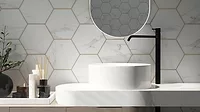Back Buttering Tile is Going Away

Examples of notched-back and flat-back mortar troweling.
Don’t get all bent out of shape over the statement that back buttering tile is going away. The term is going away, but the process is here to stay.
Back buttering, or buttering, has been practiced by many quality-oriented tile installers over time. This process includes spreading of a bond coat of mortar to the backs of the tile just before it is installed. But during that time, others known as tile placers (called as such since they don’t measure up to the status of a tile installation professional) have brought new meaning to back buttering by replacing the proper method with spot bonding. If you regularly read The Tile Tip, you know that we have no room for this devious and misguided practice.
It is for this reason that the Technical Committee of the National Tile Contractors Association (NTCA) has drafted language that clearly defines two new terms; flat-back troweling and notched-back troweling. They may seem a bit cumbersome, but when you realize that they indicate their intended purpose, there is no longer any room for spot bonding.
The NTCA Reference Manual now offers these definitions:
Flat-Back Troweling
“The application, using the flat side of the trowel (keying in or burning in), of a thin layer of modified/non-modified dry-set mortar (thinset mortar) to the backside of ceramic, porcelain, glass, and stone tile just before the tile is installed.” (Note: When done correctly, the flat side of the trowel will make a scraping sound on the tile back as pressure is applied to the surface.)
Notched-Back Troweling
“After flat back-troweling has been completed, additional modified/non-modified dry-set mortar (thinset mortar) is applied to the backside of ceramic, porcelain, glass, and stone tile and uniformly combed in one direction with an appropriate notched trowel just before the tile is installed.” (Caution: When notched back-troweling is used, the embedded thickness of the dry-set mortar cannot exceed ANSI or manufacturer requirements)
Get more on the latest products and trends in tile and stone
When these methods are used properly, they ensure increase bond strength between the mortar and the back of the tile. As seen in the attached photo, the tile on the right has a raised hexagon pattern (other may have rough profiles). The flat-back troweling fills these spaces providing a filled and smooth surface which is ready to receive and bond to the mortar that is combed on the substrate. The tile on the left demonstrates both techniques; flat-back and notched back troweling. This method can be successfully used when setting tile on a ceiling where it is much easier to spread the tile rather than the ceiling substrate. However, the mortar must always be keyed into the ceiling substrate before setting the tile. Of course, these methods only work effectively if the tile is moved in a perpendicular back and forth movement to completely collapse the ridges of the mortar into the valleys, achieving the required mortar coverage.
Do it correctly the first time, knowing a good mechanical bond and flat surface are achieved, yielding happy and returning customers. Think about it.
Looking for a reprint of this article?
From high-res PDFs to custom plaques, order your copy today!










